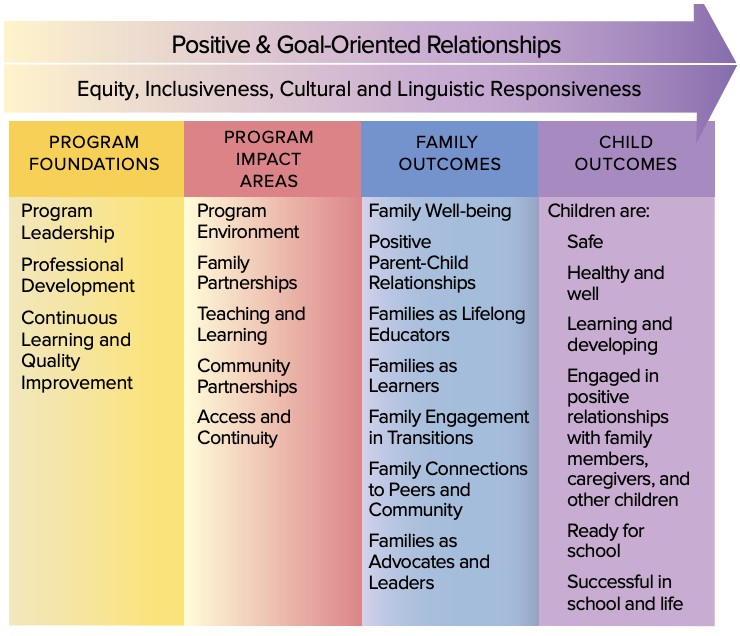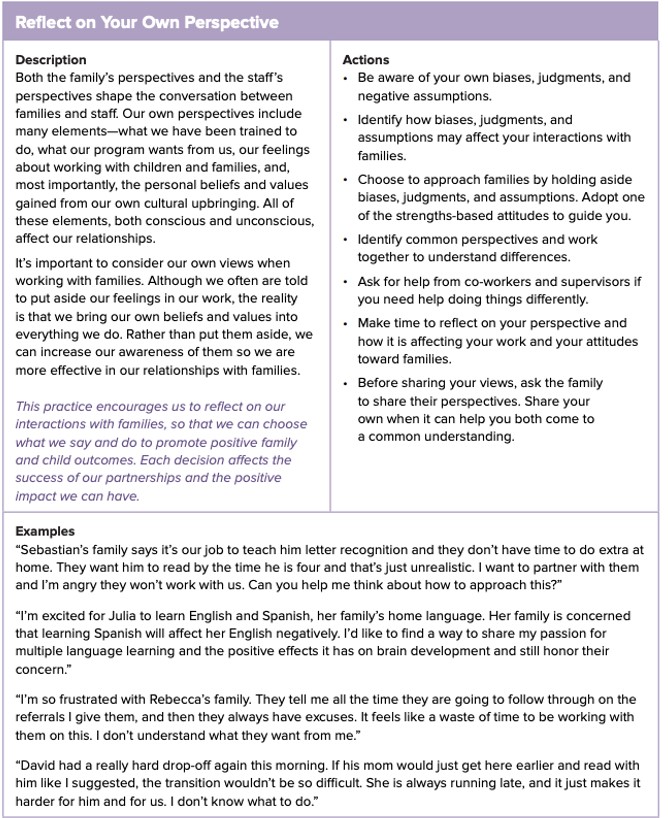2 Chapter 2: Pedagogical Leadership in an Early Childhood Setting – What does that look like?
Learning Outcomes
- Receive and integrate feedback on decision-making practices, conflict-resolution skills, and teamwork behaviours
- Lead and implement the pedagogical planning within an Early Learning and Child Care setting
- Facilitate pedagogical changes in order to stimulate educator growth and maintain currency within the Early Learning and Child Care setting
Being a Leader in Early Childhood Education Settings
In order to become a leader in the Early Childhood Education setting there are a few things that the educator needs to be aware of, such as knowing about their center, the children, their families, and the staff they work with. You need to develop a good relationship with all of these members of your ECE Community.
In this chapter we will focus on – establishing long-lasting relationships to foster leadership support.
Sustaining Effective Practice
One key to building relationships is taking the time to reflect on our work with families. When we look at what’s working and what’s not, we can make changes that strengthen our relationships with families. Individual and shared reflective practice helps us work more effectively with families and contributes to better outcomes for children and families.
Reflective Practice
Taking the time to reflect—to stop and think about what has happened, what is happening, and what should happen next—is essential to creating and maintaining Positive Goal-Oriented Relationships.
Reflection on our work with families allows us to:
- Understand how our own experiences and beliefs influence our work
- Sharpen our observation and communication skills with children and families
- Improve our skills in building mutually respectful partnerships with families
- Enhance our ability to communicate and build relationships with peers and community partners
Reflective Strategies: Self-Reflection
Self-Reflection Reflection is an important part of our own continuous improvement process to understand why and how we make the choices we do. Taking the time to look at ourselves and our work gives us the opportunity to acknowledge strengths and challenges to improve our skills.
In this section, we will explore reflective practice strategies to support our work in building relationships with families.
Observe and remember what happens with children, families, and staff:
We see and experience so much with children and families every day. It can be hard to keep track of every moment. You can record children’s progress, staff-parent interactions, and the information shared among staff. This creates an opportunity for staff to understand what does and does not work. Remembering and reflecting on our observations is useful for improving what we do. Recording our reflections in a confidential notebook can be a valuable learning activity.
Think about how your own experiences affect you and your work:
Each of us has personal and professional experiences that shape who we are. We often act in ways that are familiar and comfortable. It can be difficult to question what we already know, and think is right. Through self-reflection, we allow ourselves to understand our personal reaction (how a professional situation makes us feel) and our professional action (how we choose to respond professionally) as two separate things. Because caring for children and families is so important, and at times very emotional, we need to be aware of how our personal perspectives influence our work. This strategy is aligned with the relationship-based practice of “reflect on Your Own Perspective.”
Think about the perspectives of others:
Each family in our program is unique. Take the time to wonder about how the experiences of families may influence how they behave or respond in certain circumstances. However, keep in mind that sometimes wondering about others can be similar to making assumptions about them. We tend to rely on what we have learned and experienced in the past. Acknowledge that you may not know what is motivating someone to think or act in a certain way.
When there are opportunities to respectfully communicate about these circumstances with families, it can open us up to a greater understanding of others and of ourselves. Reflecting on the perspectives of families helps us make better sense of where they are coming from. This gives us insights about what strategies might be most effective for engaging them. This strategy is aligned with the relationship-based practice “Reflect on the family’s perspective.”
Identify stressors:
Working with children and families can be highly demanding. Professionals may experience high levels of stress when working with families who face hardships such as poverty, community violence, social spending cuts, and a shortage of jobs and affordable housing. This can lead to increased risk of job dissatisfaction and professional “burnout.”
Programs can create opportunities for staff to get the support they need and help them feel valued for the work they do every day. Leadership can prioritize regular times for individual, paired, or group reflection. Promoting self-care among staff in this way can have a positive effect on their skill and productivity.
Reflective Strategies:
Reflective Supervision
Like the relationship between a professional and a family, the relationship between a staff member and supervisor can offer qualities of mutual care and respect. Reflective supervision is an opportunity for leadership to use the strategies of reflection to foster growth, reinforce strengths, and encourage resilience. In addition to giving staff the encouragement and guidance they need; it also keeps leadership in touch with the real issues that programs face.
Structured supervision ensures that there will be times when staff may not know what to do, but that there is someone—and a time and place—dedicated to helping them express their feelings, problem solve, and strategize. If staff feel judged and constantly evaluated, then everyone misses out on opportunities for reflection, creative discussion, and meaningful growth.
Confidentiality is essential for effective supervision. It’s important for supervisors to help staff feel safe enough to take risks within the relationship. An effective strategy for establishing safety is using messages like those we use with our families, such as “You have strengths,” “Let’s talk about what you need to be successful,” and “Take care of yourself.” These messages can build resilience among staff and let them know that they are valued partners in the program.
As the supervisory relationship develops over time, supervisors and staff can share the responsibility for the quality and content of the relationship. You can discuss questions such as: How does the relationship feel? How is the time used? What topics require more attention? Shared responsibility begins with scheduling regular time for supervision. Time spent building teams and brainstorming about how to develop the work is important to everyone’s efforts. That time should be valued, built into schedules, and prioritized.
When we provide supervision, we also have the opportunity to model effective strategies to build relationships with families. It is a parallel process. How we behave with staff models how we want staff to interact with families. The Strengths-based Attitudes and Relationship-based Practices for working with families can also be adapted to build relationships with staff.
Strengths-based Attitudes for Effective Supervision
- Staff deserve the same support and respect we are asking them to give families.
- Staff are our partners with a critical role in achieving outcomes.
- Staff have expertise about their own fields of practice.
- Staff’s contributions are valuable and important.
Relationship-based Practices for Effective Supervision
- Reflect on your program staff’s perspective
Have an ongoing dialogue with your staff that allows them to have input about the structure, content, process, timing, and tone of supervision. This offers an opportunity for staff to reflect on what type of supervisory relationship they would like to have and how to negotiate goals and needs together. Ask staff to consider with you how you can work together to respond to complex situations. This can provide staff with an opportunity to consider different viewpoints within a system and reinforce teamwork.
- Support your program staff’s competence
Accentuate the positives among staff members and in the work that they do. Staff need to be reassured about their knowledge and expertise. Strengths-based supervision helps staff feel that they are valuable members of a team. Staff may feel encouraged to reflect on their own professional competencies and goals, recognize their contributions, and feel safe to explore their challenges.
- Focus on the family-staff relationship
Work with staff to learn new skills for building partnerships with families. Use strategies that help you look at what’s working and what’s not and how they can use what they discovered to determine next steps with the family.
- Value your program staff’s passion
Listen to what the staff is experiencing without judging. This may include how different situations affect their mood, concentration, motivation, ability to connect with others, and what they need from you. By creating a safe and professional space where staff can talk about their real emotions, you help each other to better understand the roots of problems and strategize about how to address them.
- Make time for your own reflection
Make time to reflect on your own experiences, goals, and challenges. As a supervisor, you often put your staff’s needs before your own. Reflection allows us to consider our reactions, responses, and options. Reflection on a past situation can help us prepare for similar events in the future. This is emotional work, and self-care is essential for you and your staff. You will need to take time for yourself to rejuvenate, reflect, and focus on your own professional development. Explore what helps you feel refreshed and inspired to learn and grow. What role can your supervisor play in your growth? How can your supervisor give you the best chance at success?
One of the joys of working with families of young children is that it creates an opportunity for everyone’s growth: the child, the parent, the provider, team members, and program leadership. Reflective supervision is one way in which programs can attend to the growth of staff. The shared experience of supervisor and staff ensures that no one is alone in doing this very important work. Just as staff feel that their work is meaningful when families grow, supervisors can find satisfaction in knowing that staff are expanding their skills and finding meaning in their work.
In order to become leaders that lead and implement the pedagogical planning in the Early Learning and Child Care setting we need to develop and strength our attitudes toward building goal-oriented relationships.
We strive to develop and build partnerships with the families and the staff at the childcare centers.
Below are some examples of the goals that an ECE leader should have in mind:
Strengths-based Attitudes for Building Positive Goal-Oriented Relationships:
- Families are the first and most important teachers of their children.
- Families are our partners with a critical role in their family’s development.
- Families have expertise about their child and their family.
- Families’ contributions are important and valuable.
Relationship-based Practices for Family Engagement
- Observe and describe the child’s behavior.
- Reflect on the family’s perspective. • Support competence.
- Focus on the family-child relationship.
- Value a family’s passion.
- Reflect on your own perspective.
Here are some areas that an ECE leader should focus on when leading in Childcare and Early Childhood settings:

Activity Time
Using the table below as a sample, reflect on your perspective within a child-family relationship and answer the following questions:
1- Reflect on a time when you used this practice with a family. What did you say or do?
2- Reflect on a time when this practice would have helped you build a relationship with a family. What would you have said or done?
Please, write your reflection on a word document. You can use between 500-700 words to answer each of the 2 questions above.

| This chapter contains material from Building Partnerships Series for Early Childhood Professionals by Early Childhood Learning and Knowledge Center and is used under a Public Domain Dedication license. |

